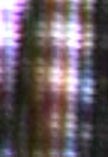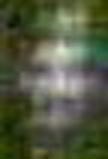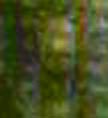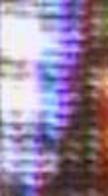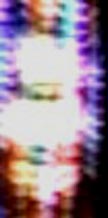First published in The Journal for Spiritual and Consciousness Studies. November 2017 (ascsi.org/)
Abstract
This is an explanation of the model being considered by the Association TransCommunication (ATransC) to help study Electronic Voice Phenomena (EVP). The model is based on lessons learned from instrumental and personal forms of mediumship, theories related to psi functioning and mainstream emerging understanding of the relationship between unconscious and conscious mind. The model is applicable to the study of many forms of transcommunication and may further understanding of mindfulness.
Introduction
EVP are voices detected in electronic equipment that, based on currently understood science, should not exist. They may occur in just about any electronic device capable of processing voice. In fact, they were reportedly found in early wire recorders and now are found in answer machines and cell phones. EVP are typically discovered during review of recordings. They are often interactive, in that they answer questions or comment on activity around the practitioner or an interested observer. It is common for people to recognize the speaker, (Gullà, 2004) leading to the belief EVP are initiated by discarnate loved ones.
For this discussion, it is necessary to at least tentatively agree that there is a nonphysical aspect of reality referred to here as the psi field or etheric. The trans- prefix is used to mean across the etheric-physical interface, as in transcommunication.
Characteristics of etheric space that are important to this model:
- Etheric space is conceptual, as opposed to the objective nature of the physical.
- Intention is modeled as the motive force for expression in the etheric.
- Influence is comparable to the physical concept of kinetic energy.
- Potential future is comparable to the physical concept of potential energy.
Point of View
Speaking in general terms, the three major contending points of view related to EVP are:
Normalist: This is the Physical Hypothesis point of view which holds that EVP are delusion, fraud or are mundane, mistaken as paranormal. In this view, the necessary science supporting mechanisms for EVP formation are not established, and therefore any reference to paranormal must be pseudoscience. This is being addressed these days as Anomalistic Psychology. (APStaff, 2015) Consciousness is a product of brain and ceases to exist when the brain dies.
Psi+ Normalist: This point of view is the Super-Psi Hypothesis, which is the Physical Hypothesis modified with the contention that the physical universe is permeated by a psi field. (Sudduth, 2009) In parapsychology, psi represents influence associated with psychic functioning. For Psi+ Normalists, if not mundane, delusion or fraud, the information in EVP is produced via psychic access to residual memory or the mind of still living people. This is beginning to be addressed as Exceptional Experiences Psychology. Consciousness is a psi field phenomenon originating from the brain.
Dualist: This point of view is represented by the Survival Hypothesis. It is the point of view that we are immortal personalities temporarily entangled with a human for this lifetime, that our conscious self existed before this lifetime and will continue to exist in a sentient, self-aware form after this lifetime.
Dualists and Psi+ Normalists generally agree that EVP are formed by way of psychokinetic influence of the practitioner on electronic equipment. Studies indicate that it is also possible that information in the message is psychically accessed from a living person’s mind or from residual memory impressed into the psi field. However, the working assumption for Dualists is that some of the messages are communication from discarnate personalities.
Pay close attention to the terminology used in parapsychology. While we expect mainstream academics to reject the Survival Hypothesis, most people actively studying things paranormal seek to prove reported experiences are not paranormal (Normalists). Others seek to show that paranormal phenomena are psychic functioning (Psi+ Normalist). For both, the arrow of creation of consciousness flies from the origin of the human body. For Dualists, the arrow of creation flies from the origin of reality.
Normalist and Psi+ Normalists speak of consciousness as a product of brain. Psi+ Normalists speak of survival as survival of residual memory which is neither sentient nor interactive in the usual sense of communication.
The Trans-Survival Hypothesis described in Your Immortal Self provides the foundation argument on which this model has been designed. (Butler, 2016) (Butler, 2015-3) The trans- prefix is used to distinguish this version to avoid confusion with the usual “Oh and some people think they survive death” version referred to in most parapsychological discussions about psi models.
Model of Consciousness
Be aware that the model of consciousness presented here is derived by an engineer via a technique known as black box analysis. In that, known input and outputs are presented to a hypothetical black box which must contain a set of functions which respond to known inputs to produce known outputs. The functional areas in the Life Field Complex Diagram represent the sort of processes I would design for a computer so as to emulate the actual processes associated with consciousness.
A person trained in consciousness studies would not necessarily recognize the functions or agree that they are reasonable representations. Nevertheless, the diagram has been useful for the study of transcommunication.
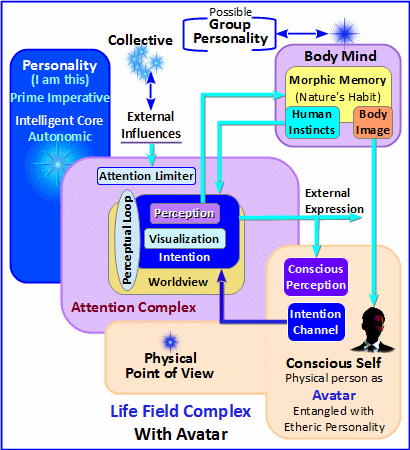
The resulting model, referred to as the Implicit Cosmology, is explained in detail in Your Immortal Self. An earlier version is available on ethericstudies.org under the Concepts tag. It is implicit because it is the consequence of survival based on the Trans-Survival Hypothesis.
Our Natural Habitat
If we existed before this lifetime and will continue to exist after, then the first point to conceptualize is that we are not our body. Think of our body as an avatar. We, as conscious self, share our human’s instincts and the early part of this lifetime is consumed with learning to override them with our more rational awareness. We are taught to think of ourselves as our body, and virtually all environmental cues reinforce this perspective. The task, then, is to learn how to think of ourselves as outside of our body in much the same way we are outside of a virtual reality device.
An important assumption of this model is that we are nonphysical in nature. Our mind is nonphysical. It is useful to think of our brain as a transmitter-receiver converting physical senses of our body to psi senses able to be processed by our mind. This seems to be a necessary consequence of our avatar relationship. We are more in agreement with our pre-lifetime awareness during the dream state.
As is illustrated in the diagram, our life field anatomy is modeled as:
- Conscious self, which is entangled with our avatar and which is the direct experiencer of our life field (the box marked Physical Point of View).
- Mostly unconscious mind, which processes sensed environmental information (Attention Complex).
- Intelligent core (Personality), which includes our purpose and acts as the nexus for our life field.
Think of a field as a zone of influence relating many elements into a single object. The source influence is the nexus. In the conceptual space of the etheric, fields are the building blocks of reality. Life fields are the top field in the hierarchy of fields. (Butler, 2015)
Worldview
The most important functional area in the Attention Complex is Worldview, which functions as a library containing memory, understanding and instincts. At birth, it is populated with human instincts inherited from the Body Mind, and spiritual urges, and a degree of understanding about the nature of reality, inherited from our Personality.
As we mature, worldview is also populated with cultural beliefs and some degree of new understanding as we learn to manage our human instincts. Spiritual instincts involve the urge to turn toward kinds of experiences most likely to provide opportunities for desired understanding. More a nuisance in our youth, for some people, spiritual instincts begin to dominate their actions as they mature.
During transition out of this lifetime, and when we are free of human instincts, it appears we experience a sorting out process as we make sense of the understanding we have gained. It is beyond the scope of this model to explain whether or not we enter into a new venue for learning. Since our purpose appears to be to gain understanding, my speculation is that we will quickly find ourselves in a new venue … physical or not.
The Perceptual Agreement Organizing Principle states: Personality must be in perceptual agreement with the aspect of reality with which it will associate. (Butler, 2016) (Butler, 2015-2) Based on that, each lifetime would presumably result in greater understanding, and therefore, our access to reality would be increased. If true, this would make other venues available to us.
In this model, our actual self is our personality (core intelligence). What we think is our actual self is only our conscious self, which is the experiencing part of our life field. All information into and out of our life field is by way of our Attention Complex (mind). No part of us, core intelligence or experiencer, is immune to the filtering of information or able to avoid the coloring of our intended action caused by worldview. Thus, in this model, the Perceptual Agreement limitation applies to all parts of our life field.
As conscious self, the only way you can change worldview is with the expression of specific intention. As I will explain below, even then, you will only be able to make incremental changes. This is why mindfulness is a life-long process. (Butler, 2014)
Morphic Fields
The idea of what I refer to as our personality acting as our intelligent core is based on a concept proposed by Rupert Sheldrake as the Hypothesis of Formative Causation. (Sheldrake) [paraphrasing] Sheldrake proposes that an organism can be modeled as a top field enfolding a hierarchy of nested fields. Each field is an organizing agent for the formation of a part of the organism. For instance, each cell in the body is organized by a field with instructions specific to that cell’s function in a many to one manner. Larger parts of the organism such as skin, bone and muscle, are represented by fields enfolding subordinate fields, and so on in a hierarchical manner.
The process of organizing the field according to Nature’s habit is referred to by Sheldrake as morphic resonance. Each type of species has a common memory or habit. Creative solutions to environmental challenges are able to change the habit, and thus effect all of the related species.
Nature’s habit is comparable to the worldview functional area in the diagram. Both have considerable momentum, meaning that they resist large changes, but will respond to influences causing small, incremental change.
As a person, we are an immortal personality entangled with human body in an avatar relationship. We share the Attention Complex with our human, and therefore our worldview. But, note that I have modeled the influence of body image on the human body as a link to the body which bypasses the Attention Complex.
The morphic field that organizes our body is based on the memory of its species. Thus, when we seek to influence our body, the model predicts that we must do so by way of the Attention Complex as a well-visualized expression. For instance, worldview is typically programmed to assume a mature body means a worn-out body. Therefore, our task is to change worldview rather than the body image. (In actuality, aging may be a cultural artifact.)
First Sight Theory
First Sight Theory proposed by James Carpenter holds that everything produces a psi signal which we are able to sense. (Carpenter, 2014) He also maintains that our every expression produces a psychokinetic signal which influences our environment according to the intention of the expression. He proposes twelve corollaries to the psi sensing and psychokinetic expression theory that can be used pretty much without modification as the ruleset for operation of the Attention Complex.
Keep in mind that First Sight Theory applies to our mostly unconscious mind. I say mostly unconscious, because our ability to consciously sense and influence functions in the Attention Complex (mind) depends on our lucidity. Lucidity is a measure of how well we have learned to quiet our mind and pay attention to those small impressions radiating from our mental processing.
Corollary 7, the Bidirectionality Corollary, indicates that we unconsciously turn toward or away from information depending on our interest as it has been expressed to our mostly unconscious mind. This corollary is important as a mechanism for our spiritual instincts to guide our unconscious decision making. It is also the mechanism we seek to influence with our conscious intention to produce changes in worldview.
The Nature of Awareness
An important consequence of this model is that we do not directly experience reality. Instead, we experience what our worldview thinks about what we experience. This is not the conjecture of an engineer speculating about phenomena. Mainstream psychology is increasingly reporting findings indicating awareness of stimuli only after the mind processes the information. (Carpenter, 2014) (Max-Planck-Gesellschaft, 2008) (Dockrill, 2016)
If you contemplate your thought processes, you will note that you visualize what you are going to say, compose the wording, and then speak, in that order. This very fast process is triggered by your intention to speak, but we only become aware of what we express as it emerges from our unconscious mind.
Since your mostly unconscious mind pre-processes information, it is simple for it to ignore some information if your worldview is so conditioned. The Attention Limiter function in the Attention Complex is based on the consequences of Corollary 7 in First Sight Theory. In fact, we ignore much of the environmental information coming to us.
Since other minds also send psi information to us, we probably ignore psi information coming from the mind of our loved ones unless our worldview is conditioned to acknowledge it. We are all natural mental mediums. It is just that some of us have a worldview that is conditioned to accept mind-to-mind information. Mindfulness is the tool by which we can take control of that conditioning task to improve lucidity.
Summation of the Model
The consequences of surviving beyond this lifetime, the fact that we are only aware of the results of unconscious processing of environmental information and the fact that we share the database for that processing with our body, must be part of our sense of who we are. The alternative would seem to be self-delusion.
This model, or one like it, must also be part of the explanation for the phenomena we experience. If the model is largely correct, the etheric aspect of who we are is the same as our discarnate communicators. The only difference is our entanglement with a human avatar.
The relationship of our five physical senses to our mind, what we sense psychically and mediumistic communication with a loved one, are only different in intention and the meaning for them we have been conditioned to assign.
The only conscious influence we have on what we sense and express is our intention, and even that is conditional, based on the momentum of our mostly unconscious worldview. The awakening mystics speak of is a person’s emerging realization that there is a difference between personal reality dictated by worldview and actual reality … followed by the determination to align personal reality with actual reality.
As is discussed below, a person (spirit entangled with a human) is the conduit through which paranormal phenomena must pass to cause physical effects. This may be facilitated by our avatar relationship, while our discarnate communicators do not have the physical perspective apparently necessary for their worldview to assign physicality.
Anomalistic and Exceptional Experiences Psychologists are correct in thinking point of view influences experiences, but they ignore the reasons. If we believe in paranormal phenomena, then we are telling our Attention Complex to process environmental information deemed paranormal, rather than rejecting it because it does not agree with worldview. Based on the Principle of Perceptual Agreement, people who accept what their worldview shows them tend to be blind to more of reality than those who question their perception.
Formation of EVP
Using ATransC nomenclature, the most common forms of reported EVP are transform, opportunistic and left message: (Butler, 2010)
Transform EVP: Available noise is transformed into voice. Collection of transform EVP examples is accomplished by using a simple audio recorder. If there is not sufficient ambient noise, it might be added with a small fan. A common practice used in the early days of EVP, but discouraged today, was to tune a radio between stations so as to produce radio static for voice formation. Although the voices might be heard when they are formed, they are typically not heard until playback of the recording.
Transform EVP is the most common form and the only form ATransC considers useful for research. The models being developed to help understand survival and our etheric-physical nature also support the formation of transform EVP.
Opportunistic EVP: This is typically a live voice technique, meaning that a physical person’s speech is recorded and used for background noise. The live voice is thought to be changed between the source and the recorder. Foreign language is usually used.
In the radio-sweep technique, the tuner of a radio is swept to opportunistically produce an output stream formed of the required bits of radio broadcast sound. It appears to be necessary for intended order to be in the form of compelling a person to produce the required sound at the needed moment. (Possible violation of self-determination; think Seth’s “Do not violate.”)
A third technique for opportunistic EVP is storage of pre-recorded voice in a digital buffer, and then the random selection of buffer addresses to produce an output sound stream composed of bits of voice from the pre-recorded voice. A random process in the computer program may be used for selecting storage addresses, but an environmental detector, such as a radio-frequency, magnetic or temperature detector might also be used. EVP are thought to be formed via psychokinetic manipulation of the random process.
After experimentation and review of hundreds of examples, it has become ATransC policy that the frequency of false positives produced by opportunistic techniques makes it virtually useless for any but the most informed research. (Butler, 2011) (Butler, 2012) (Heinen, 2010) (Leary, 2013) (Butler, 2009)
None of the models being developed to help understand survival and our etheric-physical nature support the formation of radio-sweep EVP.
As a compounding factor for evaluation of these techniques by less experienced practitioners, transform EVP may be found in the resulting noise stream inadvertently produced by all such techniques.
Left Message EVP: This category includes messages left on telephone answering machines and phone calls. There is much less known about this form of EVP, as they are typically spontaneous events while transform and opportunistic EVP are typically induced, in that contact is initiated by a practitioner. The mechanisms involved in the formation of left message EVP appears to be the same as for transform EVP.
Stochastic Resonance
The only physical process we have identified that accounts for the physical changes in an audio stream is stochastic amplification. (Abbott, 2009) In that, a small signal can be amplified when mixed with a broad-spectrum noise signal in a nonlinear analog amplifier circuit. This phenomenon is sometimes used in telecommunication as a way of extending the range of transmission between signal regenerators.
In one view of this, a small psychokinetic influence is thought to be amplified via Stochastic amplification as if it were a physical sound stream. The second theory requires an understanding of how the intended order concept is used here.
Intended Order
The Expression Organizing Principle is important to this discussion. It is defined as: Reality is expressed via personality’s attention on an imagined outcome with the intention to make it so. (Butler, 2016) (Butler, 2015-2) If it is true that every act is intentional, then reality is the product of intention or intended order. (This is also the definition used for the creative process.)
We have noted that a random process is involved in most paranormal phenomena. For instance, at least some of the examples of precipitation art require the availability of raw, randomly organized material to be used in the art. Most visual forms of ITC require chaotic noise as the raw stuff for feature formation. Noise is transformed into voice in transform EVP.
The Random Event Generators (REG) used for consciousness research respond to attention by becoming less random. In terms of order, the only difference between an REG signal and audio or visual noise is scale. As I read the physics, the impression of intention on noise by way of stochastic amplification holds for all of these.
Etheric-to-Physical Interface
Etheric space is conceptual while physical space is objective, and so, a transforming process is necessary for one to influence the other. In this model, a concept is defined as a fundamental idea; a root thoughtform from which systems of thought can be derived. Objective means those aspects of our world we can experience with physical senses. Sensed information is transformed into psi signals to which we assign physicality, even though they are not otherwise different from other signals we receive.
An important concept concerning this interface is energy well. In a single-tone sound stream, each next cycle is the same as the preceding cycle. Such a signal is very stable, and conceptually, great stability represents a very deep energy well which is more difficult to influence than a shallow well. This can be seen in EVP formation, as the psi influence necessary to change a single-tone signal appears to be greater than that needed to change a more random signal.
In this model, it is not the size or mass of an object to be concerned with for psychokinetic influence. It is the energy well associated with the idea of its stability. Both views may have the same result, but the difference in focus helps us understand why noise with few variations produce fewer EVP than noise with many perturbations. It appears that noise spikes help initiate voice formation.
Cultural Contamination
A common factor in EVP is apparent coloring of the message according to the practitioner or interested observer’s worldview. In the simplest example, two people will record for EVP in the same room. The one who is not afraid of the dark records useful information and the one who is afraid, records scary messages such as “Get out!” and “I hate you!” We also see this sort of cultural contamination in mental mediumship, as mediums color messages based on personal beliefs.
In fact, we see no evidence in any of our ITC to support the notion of evil in the biblical sense. Yes, we find people behaving poorly, but not kill your soul evil. We also see no evidence or foundation in the metaphysics for earthbound souls. The Principle of Perceptual Agreement is the only organizing factor we have noted that limits our access to reality via self-determination.
The takeaway from the cultural contamination concept is that a discarnate communicator may initiate an EVP but the message is first sensed by the practitioner or interested observer’s mostly unconscious mind as a conceptual thoughtform. There, it is matched up to worldview before being expressed into the physical as intended order. In this way, an intended message of “Please leave me alone” from a discarnate communicator may produce a “Get out” EVP if the practitioner or interested observer expects scary messages.
Cultural contamination is easily seen in EVP. The same model used for EVP is used for mental mediumship or channeling or watching television. A person who has learned to be more lucid by way of mindfulness will probably be subject to less contamination, but in practice, it is a part of the human condition.
Concluding Comments
Emerging understanding about how we think is making it difficult to ignore the part our nonphysical aspect plays in our daily living. This idea of an inner, spiritual self and an outer, physical self is no longer the domain of mystics and New Age believers. While scientists are more willing to say that mental processing comes before conscious awareness, a decidedly etheric concept, they are reluctant to merge their theories with parapsychological models.
Be pragmatic. It is well-established fact that EVP exist as anomalous voices found in electronic equipment. Fraudulent EVP are not EVP; they are fakes. If a person mistakes ambient sounds for EVP, he or she needs training, rather than their error being evidence of delusion. Training is our community’s biggest problem and one only you can fix.
Be clear about the consequences of what you accept as true. Beware what your friends think is true, and examine beliefs of the author whose literature you depend on for learned guidance. Question the consequences of every thought and claim.
EVP are a well-established form of transcommunication. If you have examined it and remain unconvinced, perhaps your source needs more training. Certainly, there are examples that can only be reasonably discounted by ignoring known natural principles.
References
Abbott, Mark D. McDonnell and Derek. 2009. “What Is Stochastic Resonance? Definitions, Misconceptions, Debates, and Its Relevance to Biology.” NCBI, PMC, US National Library of Medicine. ncbi.nlm.nih.gov/pmc/articles/PMC2660436/.
APStaff. 2015. “What is Anomalistic Psychology?” Goldsmiths, University of London. gold.ac.uk/apru/what/.
Butler, Tom and Lisa. 2012. “Using Live Voice Input Files for EVP.” Association TransCommunication. atransc.org/live-voice/.
Butler, Tom. 2015. “Etheric Fields.” Etheric Studies. ethericstudies.org/etheric-fields/.
Butler, Tom. 2011. “EVPmaker with Allophones: Where are We Now?” Association TransCommunication. atransc.org/evpmaker-study-where-are-we-now/.
Butler, Tom. 2010. “Locating EVP Formation and Detecting False Positives.” Association TransCommunication. atransc.org/locating-false-positives/.
Butler, Tom. 2014. “Mindfulness.” Etheric Studies. ethericstudies.org/mindfulness/.
Butler, Tom. 2015-2. “Organizing Principles.” Etheric Studies. ethericstudies.org/organizing-principles/.
Butler, Tom. 2009. “Radio-Sweep: A Case Study.” Association TransCommunication. atransc.org/radiosweep-study1/.
Butler, Tom. 2015-3. “Trans-survival Hypothesis.” Etheric Studies. ethericstudies.org/trans-survival-hypothesis/.
Butler, Tom. 2016. Your Immortal Self, Exploring the Mindful Way. AA-EVP Publishing, Reno, NV. ISBN 978-0-9727493-8-1. ethericstudies.org/immortal_self/.
Carpenter, James. 2014. “First Sight: A Model and A Theory of Psi.” James Carpenter. drjimcarpenter.com/about/documents/FirstSightformindfield.pdf.
Dockrill, Peter. 2016. “Consciousness Occurs in ‘Time Slices’ Lasting Only Milliseconds, Study Suggests.” Science Alert. sciencealert.com/consciousness-occurs-in-time-slices-lasting-only-milliseconds-study-suggests.
Gullà, Daniele. 2004. “Computer–Based Analysis of Supposed Paranormal Voice: The Question of Anomalies Detected and Speaker Identification.” Association TransCommunication. atransc.org/gulla-voice-analysis/.
Heinen, Cindy. 2010. “Information Gathering Using EVPmaker With Allophone: A Yearlong Trial.” Association TransCommunication. atransc.org/information-gathering-using-evpmaker/.
Leary, Mark. 2013. “A Research Study into the Interpretation of EVP – Three parts.” Association TransCommunication. atransc.org/radiosweep-study2/.
Max-Planck-Gesellschaft. 2008. “Decision-making May Be Surprisingly Unconscious Activity.” Science Daily. sciencedaily.com/releases/2008/04/080414145705.htm.
Sheldrake, Rupert PhD. “Morphic Resonance and Morphic Fields.” Rupert Sheldrake. sheldrake.org/research/morphic-resonance/introduction?.
Sudduth, Michael. 2009. “Super-Psi and the Survivalist Interpretation of Mediumship.” Cup of Nirvana. michaelsudduth.com/wp-content/uploads/2016/01/SurvivalMediumship.pdf.
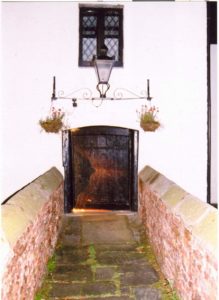




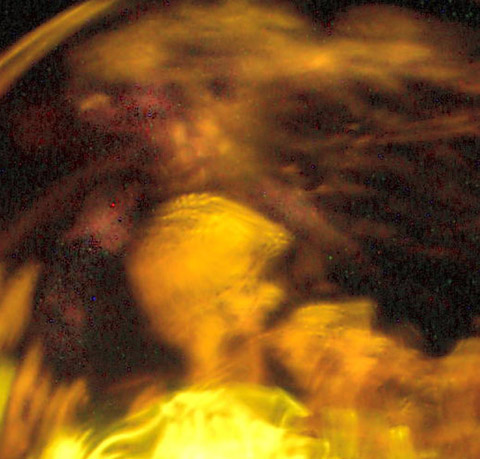
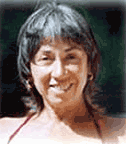
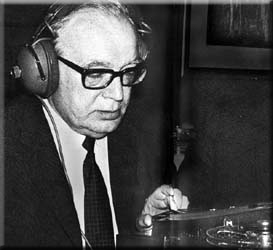

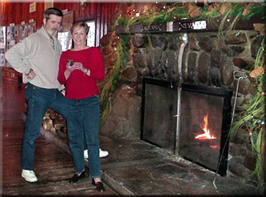

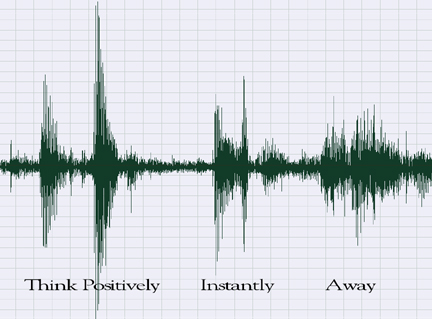
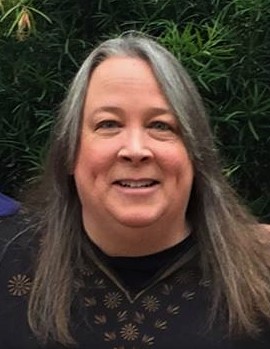
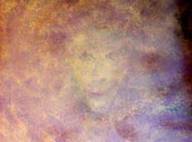

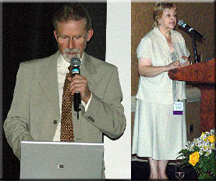

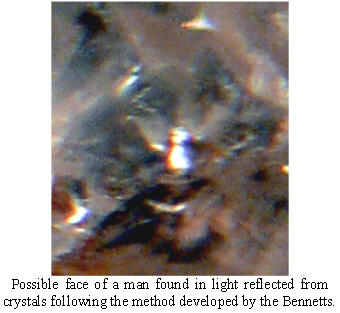
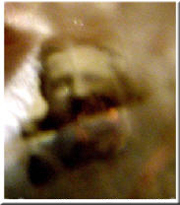
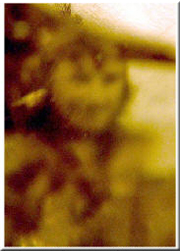

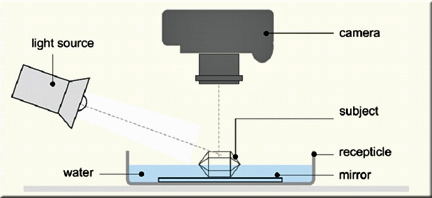
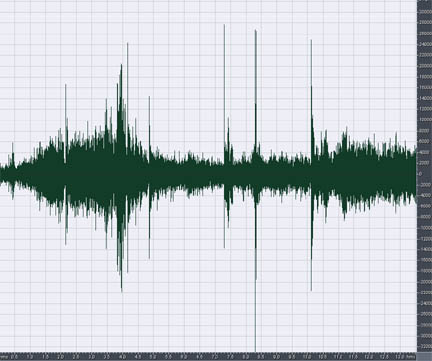



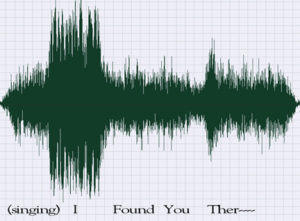
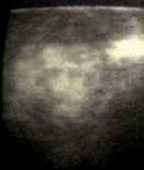 Please note: Phyllis worked with Paulo Cabral between 1998 and 2007 when Paulo made his transition. The Video loopback pictures below were recorded by them.
Please note: Phyllis worked with Paulo Cabral between 1998 and 2007 when Paulo made his transition. The Video loopback pictures below were recorded by them.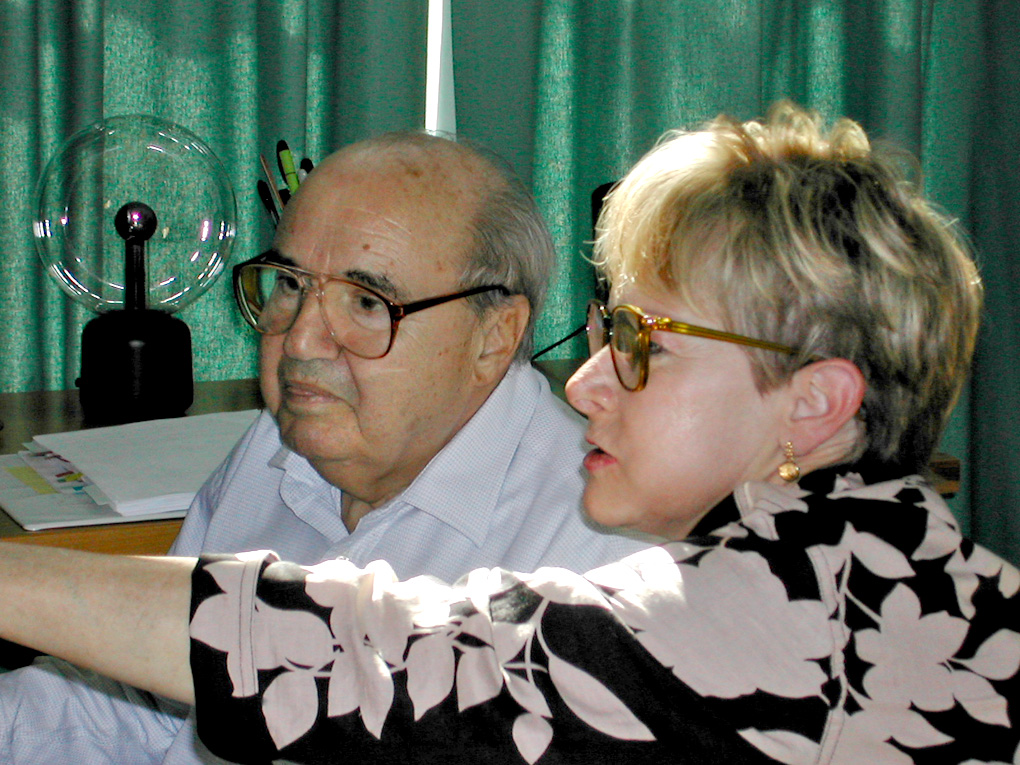
 We have been so inspired by the amazing results of Diane and Alan Bennett, and their results from reflecting light off of crystals, that we had been wanting to also try experimenting in this way. Diana and Alan had been kind enough to provide a couple of diagrams of their experimental setups, and we now had a higher resolution camera, so set up an area in the ITC room to run a couple of crystal experiments. After arranging the camera, lights and crystal in a configuration we felt would work, we did our normal meditation and then took a few pictures. We actually recorded some interesting results on our first attempts. The fourth experiment brought several more faces along with this interesting three-dimensional face. We were very pleased with the open mouth, as the mouth is often obscured in many of our pictures.
We have been so inspired by the amazing results of Diane and Alan Bennett, and their results from reflecting light off of crystals, that we had been wanting to also try experimenting in this way. Diana and Alan had been kind enough to provide a couple of diagrams of their experimental setups, and we now had a higher resolution camera, so set up an area in the ITC room to run a couple of crystal experiments. After arranging the camera, lights and crystal in a configuration we felt would work, we did our normal meditation and then took a few pictures. We actually recorded some interesting results on our first attempts. The fourth experiment brought several more faces along with this interesting three-dimensional face. We were very pleased with the open mouth, as the mouth is often obscured in many of our pictures.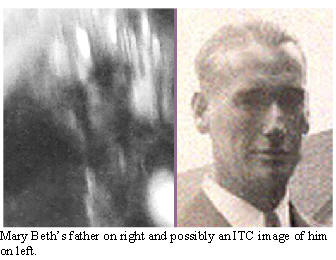 Our next success with the crystal experiments was quite a surprise. We met with a small group every Sunday morning for an hour of meditation. After our meditation, one of the members, Mary Beth, handed Lisa a picture of her parents and ask us to keep a lookout for them in our experiments. Lisa asked her to write the names of her parents on the back of the picture and then put it on her desk when we returned home. That afternoon we did another meditation on our own and conducted a few EVP experiments to test various settings on the two recorders we would be using at a video session for a shoot with the Sci Fi channel. We also worked with reflecting light off a couple of different crystals. When we looked at the results, the image of a man was clearly seen on the very first picture. The resemblance between the ITC picture and Mary Beth’s dad was noted with surprise. It was like he had heard her and stopped by during our experiment to make sure she got an ITC picture of him.
Our next success with the crystal experiments was quite a surprise. We met with a small group every Sunday morning for an hour of meditation. After our meditation, one of the members, Mary Beth, handed Lisa a picture of her parents and ask us to keep a lookout for them in our experiments. Lisa asked her to write the names of her parents on the back of the picture and then put it on her desk when we returned home. That afternoon we did another meditation on our own and conducted a few EVP experiments to test various settings on the two recorders we would be using at a video session for a shoot with the Sci Fi channel. We also worked with reflecting light off a couple of different crystals. When we looked at the results, the image of a man was clearly seen on the very first picture. The resemblance between the ITC picture and Mary Beth’s dad was noted with surprise. It was like he had heard her and stopped by during our experiment to make sure she got an ITC picture of him.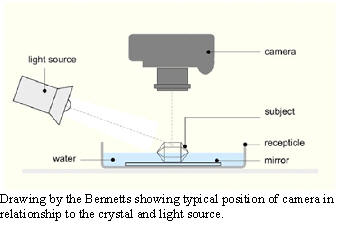 Mary Beth felt that it was her father. We were so surprised with his answering her request so quickly that we wondered if he had been a powerful medium or something, but she explained that she had never known her father. He had left her mother before she was born. He had crossed over many years ago and they had never met. Mary Beth also told us that she had received a message from a medium at a Spiritualist church who had asked her who Franklin was (this was her father’s middle name). The medium told her that Franklin was saying that he was sorry that he had not been part of her life. We were honored that the picture was so meaningful to Mary Beth and we also felt that the positive result was also due to the wonderful positive energy of our meditation group.
Mary Beth felt that it was her father. We were so surprised with his answering her request so quickly that we wondered if he had been a powerful medium or something, but she explained that she had never known her father. He had left her mother before she was born. He had crossed over many years ago and they had never met. Mary Beth also told us that she had received a message from a medium at a Spiritualist church who had asked her who Franklin was (this was her father’s middle name). The medium told her that Franklin was saying that he was sorry that he had not been part of her life. We were honored that the picture was so meaningful to Mary Beth and we also felt that the positive result was also due to the wonderful positive energy of our meditation group.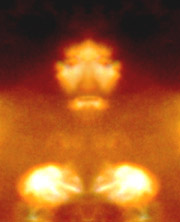
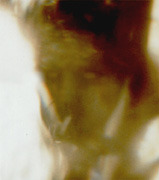

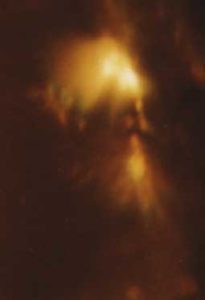
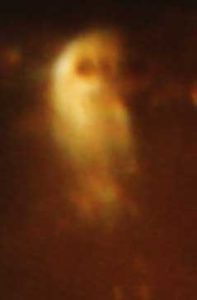

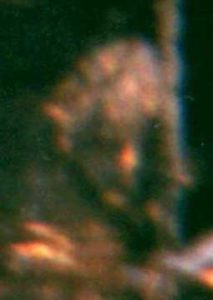
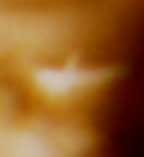

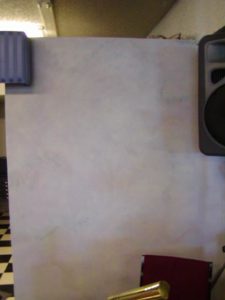
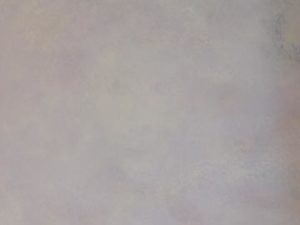
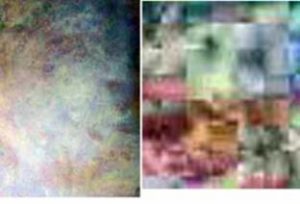 There is evidence that the communicating entity is able to use any chaotic, well illuminated optical environment to produce their images. One person even found a decent face in well illuminated piece of sandpaper. (See the example here) This would be predicted by our working hypothesis.
There is evidence that the communicating entity is able to use any chaotic, well illuminated optical environment to produce their images. One person even found a decent face in well illuminated piece of sandpaper. (See the example here) This would be predicted by our working hypothesis.
 We cannot make the claim that they are the same, but other than the obvious similarities in facial characteristics, when the image was collected is evidential. The church congregation conducted a meditation at the church just before it was closed for the summer. At that time, they asked the lady on the wall to appear to other people. That was on a Sunday and the ITC images were collected by a Spiritualist development group in Reno, NV the following Monday evening.
We cannot make the claim that they are the same, but other than the obvious similarities in facial characteristics, when the image was collected is evidential. The church congregation conducted a meditation at the church just before it was closed for the summer. At that time, they asked the lady on the wall to appear to other people. That was on a Sunday and the ITC images were collected by a Spiritualist development group in Reno, NV the following Monday evening.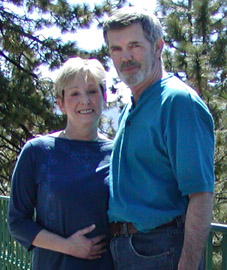
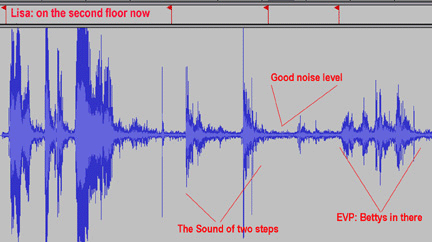
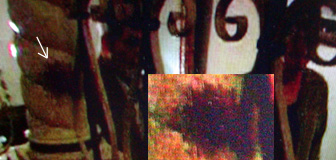
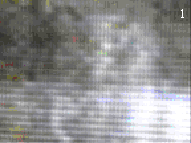
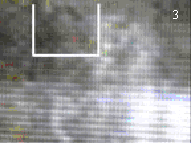 This is an example of a frame that has a major feature with an inserted feature and numerous fractal images. The insert-like feature of Image 4 (below) has been outlined in Image 3 has.
This is an example of a frame that has a major feature with an inserted feature and numerous fractal images. The insert-like feature of Image 4 (below) has been outlined in Image 3 has. Using editing software that came with Erland Babcock’s Toshiba PDR-M70 digital camera, the insert feature outlined in Image 3 was clipped and enhanced. You can see that the color has changed considerably; however, as things often are with EVP and ITC, the resulting color shift appears to provide a likely rendition for the man. You should be able to see a man from the chest up, wearing a black hat and a full beard.
Using editing software that came with Erland Babcock’s Toshiba PDR-M70 digital camera, the insert feature outlined in Image 3 was clipped and enhanced. You can see that the color has changed considerably; however, as things often are with EVP and ITC, the resulting color shift appears to provide a likely rendition for the man. You should be able to see a man from the chest up, wearing a black hat and a full beard.
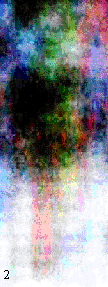
 This feature appears to be a standing man wearing light-colored pants and a black blazer. He has a handlebar mustache and apparently short-cut or slicked-back hair. You can see that he is holding something in his right hand. It is hard to see in this version of the image (different photo editing software tends to highlight different features of these images), but the man has his left hand near his throat as if he has something slung over his shoulder. The picture at the right is of the famous medium Douglas Home. We believe this ITC example may be Douglas Home; however, there is of course, no way of being certain and we do not make the claim here.
This feature appears to be a standing man wearing light-colored pants and a black blazer. He has a handlebar mustache and apparently short-cut or slicked-back hair. You can see that he is holding something in his right hand. It is hard to see in this version of the image (different photo editing software tends to highlight different features of these images), but the man has his left hand near his throat as if he has something slung over his shoulder. The picture at the right is of the famous medium Douglas Home. We believe this ITC example may be Douglas Home; however, there is of course, no way of being certain and we do not make the claim here.
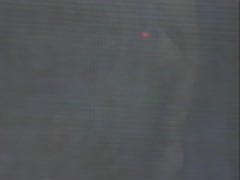
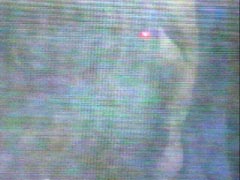 The frame to the far left is the original of this series. The second frame is the first, but enhanced to better show the detail. If you look closely, you will see a major feature that looks a little like the left side of a man’s face. The nose would be just to the right of the red dot, which is the reflection of the “Record” light of the video camera. However, we do not claim that this is a very convincing image. What we want to show you is what you see when the frame is rotated 180 degrees. This is shown in the third image of this series.
The frame to the far left is the original of this series. The second frame is the first, but enhanced to better show the detail. If you look closely, you will see a major feature that looks a little like the left side of a man’s face. The nose would be just to the right of the red dot, which is the reflection of the “Record” light of the video camera. However, we do not claim that this is a very convincing image. What we want to show you is what you see when the frame is rotated 180 degrees. This is shown in the third image of this series.
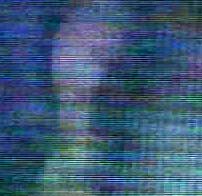 The lower lob of the “chin” in the above frames is cropped and enhanced to the left. You will see a bald head, two large eyes and an apparently determined look on a face–human or otherwise.
The lower lob of the “chin” in the above frames is cropped and enhanced to the left. You will see a bald head, two large eyes and an apparently determined look on a face–human or otherwise.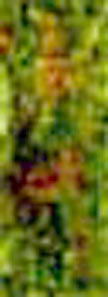 Of course, we do not know who or what this image represents. However, if you are familiar with the Irish legion of Little people and the popular New Age concepts of nature spirits, you will see that this man is very reminiscent of an elf. We see a little man mostly cloaked by green foliage. he seems to have something of a beard and mustache and is definitely wearing a domed hat with a dark brown band. We collected several such images in this ITC session conducted just before Saint Patrick’s Day. The image below was also in this session.
Of course, we do not know who or what this image represents. However, if you are familiar with the Irish legion of Little people and the popular New Age concepts of nature spirits, you will see that this man is very reminiscent of an elf. We see a little man mostly cloaked by green foliage. he seems to have something of a beard and mustache and is definitely wearing a domed hat with a dark brown band. We collected several such images in this ITC session conducted just before Saint Patrick’s Day. The image below was also in this session.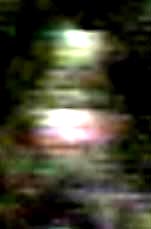 This is another ‘Elfish” feature. We will not further address the question of the Little People here, but we would like to point out a most fascinating aspect of the features we are collecting. The feature at the left appears to be that of a man who is looking to your right. He is wearing a tall hat and has a rather elongated chin. You can see his right eye rather well and most of his left. Focus your eyes until you can see this.
This is another ‘Elfish” feature. We will not further address the question of the Little People here, but we would like to point out a most fascinating aspect of the features we are collecting. The feature at the left appears to be that of a man who is looking to your right. He is wearing a tall hat and has a rather elongated chin. You can see his right eye rather well and most of his left. Focus your eyes until you can see this.
 This feature was found by rotating a frame to the left 90 degrees and represents only three or four percent of the original frame. It appears to us to be a person, possibly a woman, wearing a breastplate and some kind of headdress. Obviously we cannot know for certain, but we tend to think of this person as a shaman or one of the “Little People.”
This feature was found by rotating a frame to the left 90 degrees and represents only three or four percent of the original frame. It appears to us to be a person, possibly a woman, wearing a breastplate and some kind of headdress. Obviously we cannot know for certain, but we tend to think of this person as a shaman or one of the “Little People.”
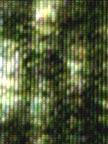
 Here are two examples of holographic feature. You should be able to see at least four faces in the first image. The features are not well developed but they are obviously features that look like faces. The frame has been rotated 90 degrees to the left. It is common for us to find bands of light and dark video noise which is a product of the video feedback loop. It is also common for us to find rows of faces in these bands of lighter noise.
Here are two examples of holographic feature. You should be able to see at least four faces in the first image. The features are not well developed but they are obviously features that look like faces. The frame has been rotated 90 degrees to the left. It is common for us to find bands of light and dark video noise which is a product of the video feedback loop. It is also common for us to find rows of faces in these bands of lighter noise.
 As we said earlier, we are collecting quite a number of people wearing hats. As with this feature, most are not particularly clear. This is offered here as a typical example. You should see a person (probably a man) looking just to your left. He has a black hat.
As we said earlier, we are collecting quite a number of people wearing hats. As with this feature, most are not particularly clear. This is offered here as a typical example. You should see a person (probably a man) looking just to your left. He has a black hat.